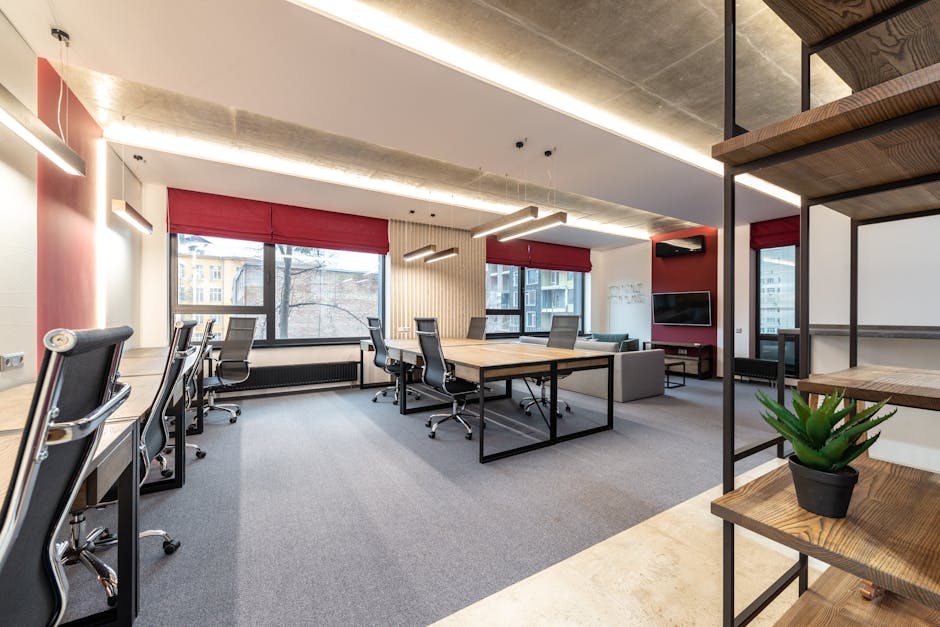Revolutionizing Workspaces: The Ultimate Guide to Agile Workplace Design
“Explore the concept of agile workplace design and its impact on modern offices. Learn how to create flexible, adaptable spaces that enhance collaboration, productivity, and employee well-being. This comprehensive guide covers key elements, benefits, and implementation strategies for agile workspaces. ”

The Rise of Agile Workplace Design: Transforming Modern Offices
In today's rapidly evolving business landscape, organizations are constantly seeking ways to enhance productivity, foster innovation, and attract top talent. One approach that has gained significant traction is agile workplace design. This innovative concept is revolutionizing how we think about office spaces and work environments.

Agile workplace design is more than just a buzzword; it's a comprehensive approach to creating flexible, adaptable spaces that cater to the diverse needs of modern workers. By breaking down traditional office barriers and offering multi-purpose areas, agile workplaces empower employees to choose how and where they work within the office environment.
Key Elements of Agile Workplace Design
Flexibility and Adaptability
The cornerstone of agile workplace design is flexibility. These spaces are designed to be easily reconfigured to accommodate different work styles, team sizes, and project requirements. Movable furniture, modular walls, and versatile technology solutions are essential components that allow for quick adaptations.
Variety of Work Settings
An agile workplace typically includes a range of different work settings to support various tasks and work styles. These may include:
- Open collaboration areas
- Quiet focus zones
- Meeting rooms of different sizes
- Informal breakout spaces
- Standing desks and ergonomic seating options
Technology Integration
Seamless technology integration is crucial for supporting agile work practices. This includes robust Wi-Fi coverage, ample power outlets, and easy-to-use meeting management systems for booking spaces and resources.
Biophilic Design Elements
Incorporating natural elements into the workspace, known as biophilic design, is often a key feature of agile workplaces. This can include indoor plants, natural lighting, and materials that mimic nature, all of which contribute to improved well-being and productivity.

Benefits of Agile Workplace Design
Enhanced Collaboration and Creativity
By removing physical barriers and creating diverse work settings, agile workplaces naturally foster increased collaboration and creativity. Employees can easily move between different areas, encouraging spontaneous interactions and idea-sharing.
Improved Employee Well-being
Agile workplaces often prioritize employee well-being through ergonomic furniture, natural light, and spaces designed for both focus and relaxation. This focus on wellness in the workplace can lead to reduced stress levels and increased job satisfaction.
Increased Productivity
With the freedom to choose the most suitable work environment for their current task, employees can optimize their productivity. Whether they need a quiet space for focused work or a collaborative area for brainstorming, the agile workplace provides options to suit various work styles.
Cost Efficiency
Agile workplace design can lead to more efficient use of office space, potentially reducing real estate costs. The flexibility of these spaces also means they can adapt to changing business needs without expensive renovations.
Implementing Agile Workplace Design
Assess Current Needs and Culture
Before implementing an agile workplace design, it's crucial to assess your organization's current needs, work culture, and employee preferences. Conduct surveys and interviews to gather insights that will inform your design decisions.
Start with a Pilot Program
Consider starting with a pilot program in a specific department or area of the office. This allows you to test the concept, gather feedback, and make adjustments before rolling out the design company-wide.
Invest in the Right Technology
Ensure your agile workplace is supported by the right technology. This may include space management tools for booking desks and meeting rooms, as well as collaboration software to support remote and in-office teamwork.
Provide Training and Support
As with any significant change, it's important to provide training and support to help employees adapt to the new agile workplace. This may include guidelines on how to use different spaces effectively and etiquette for shared areas.

Challenges and Considerations
While agile workplace design offers numerous benefits, it's not without challenges. Some employees may struggle with the lack of personal space or find open environments distracting. It's important to address these concerns and provide solutions, such as quiet zones or lockers for personal belongings.
Additionally, managing space utilization and ensuring equitable access to popular areas can be challenging. Implementing a robust booking system and regularly analyzing usage data can help address these issues.
The Future of Agile Workplace Design
As work continues to evolve, so too will agile workplace design. Future trends may include:
- Increased integration of virtual and augmented reality for remote collaboration
- More emphasis on sustainability and eco-friendly design elements
- Greater use of AI and IoT devices to optimize space utilization and employee comfort
Conclusion
Agile workplace design represents a significant shift in how we think about and interact with our work environments. By creating flexible, employee-centric spaces, organizations can foster collaboration, boost productivity, and adapt to the changing needs of their workforce. As we move forward, the principles of agile design will likely play an increasingly important role in shaping the offices of the future.
Implementing an agile workplace design requires careful planning, employee input, and a willingness to iterate based on feedback and data. However, for organizations willing to embrace this approach, the benefits can be substantial, leading to a more engaged, productive, and satisfied workforce.